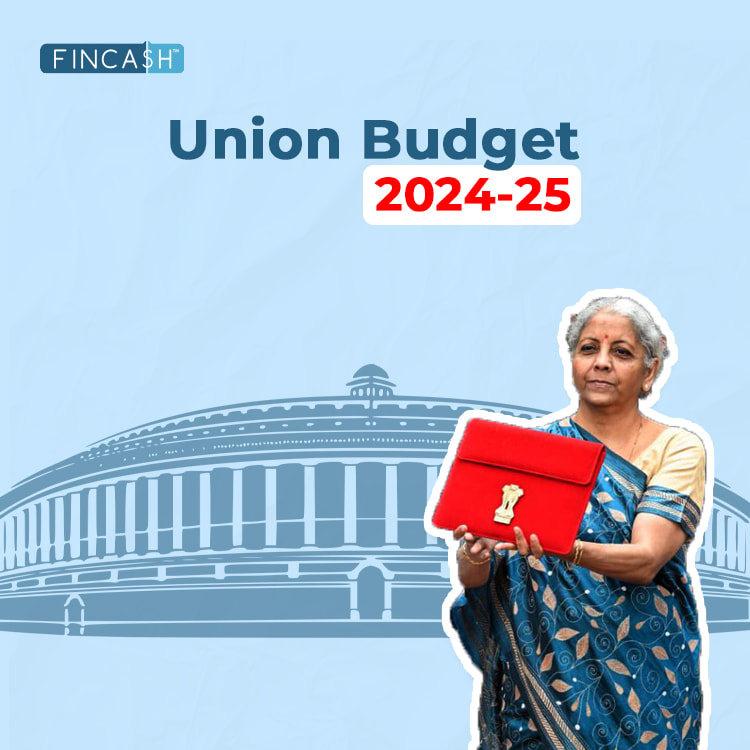
Table of Contents
- Key Priorities Outlined in the Union Budget 2024-25
- Key Highlights from the Union Budget 2024-25
- Old Tax Rate
- Revised Tax Rate Under New Tax Regime
- Capital Gains Tax
- Employment and Skilling
- MSME and Manufacturing Support
- Financial Initiatives
- Agriculture and Rural Development
- Natural Farming
- Infrastructure and Regional Development
- Economic Outlook
- Women-Led Development
- Social Welfare
- Digital and Technological Advancements
- Budget Estimates 2024-25
- Conclusion
Everything to Know About Union Budget 2024-25
Finance Minister Nirmala Sitharaman presented her seventh consecutive Budget on July 23, marking a historic milestone exceeding former Prime Minister Morarji Desai's record. This budget introduced several significant announcements, the first since the BJP-led NDA government's reelection in June.
Ms Sitharaman implemented higher standard deductions and updated tax rates for salaried individuals within the new tax framework. Additionally, reductions in customs duties on items such as gold, silver, mobile phones, and other goods were unveiled. The government's planned FY25 Capex expenditure remains at ₹11.1 lakh crore, consistent with the Interim Budget, with infrastructure spending set at 3.4% of Gross Domestic Product (GDP). In this post, let’s understand everything included in the union budget 2024-2025.
Key Priorities Outlined in the Union Budget 2024-25
The Union Budget 2024-25 outlined nine key priorities aimed at fostering extensive opportunities, including boosting:
- Productivity and Resilience in Agriculture
- Employment and Skilling
- Inclusive Human Resource Development and Social Justice
- Manufacturing and Services
- Urban Development
- Energy Security
- Infrastructure
- Innovation, Research and Development
- Next Generation Reforms
Ms Sitharaman also unveiled substantial initiatives benefiting Bihar and Andhra Pradesh, such as enhanced infrastructure development and special financial support. Additionally, she announced the abolition of angel tax across all categories of investors in startups.
Among them, Ms Sitharaman declared the withdrawal of the 2% equalisation levy and proposed increasing the standard Deduction for salaried employees to ₹75,000 under the new income tax regime for FY25.
Talk to our investment specialist
Key Highlights from the Union Budget 2024-25
Here are some of the key highlights from the union budget 2024-25:
Old Tax Rate
The new budget has announced changes to the tax slab. However, to understand the changes, let’s have a look at the old Tax Rate first:
| Tax Bracket | Old Tax Slab 2023-24 |
|---|---|
| Up to ₹3 lakhs | Nil |
| ₹3 lakhs - ₹6 lakhs | 5% |
| ₹6 lakhs - ₹9 lakhs | 10% |
| ₹9 lakhs - ₹12 lakhs | 15% |
| ₹12 lakhs - ₹15 lakhs | 20% |
| Above ₹15 lakhs | 30% |
Revised Tax Rate Under New Tax Regime
Here are the revised tax rates as announced under the new tax regime:
| Tax Bracket | New Tax Slab 2024-25 |
|---|---|
| ₹0 - ₹3 lakhs | Nil |
| ₹3 lakhs - ₹7 lakhs | 5% |
| ₹7 lakhs - ₹10 lakhs | 10% |
| ₹10 lakhs - ₹12 lakhs | 15% |
| ₹12 lakhs - ₹15 lakhs | 20% |
| Above ₹15 lakhs | 30% |
Capital Gains Tax
- Short-term Capital Gain tax was revised to 20%, and term Capital gain tax was increased to 12.5% on Financial Assets
- Securities Transaction Tax (STT) on derivatives raised to 0.02%
Employment and Skilling
- Five schemes to target 4.1 crore youth over five years with a central outlay of ₹2 lakh crore
- Over five years, a comprehensive internship scheme for one crore youth in leading 500 companies
- Employment-linked incentives, including one month's wage support for first-time employees
- Programmes focused on women-specific skilling and increasing workforce participation
MSME and Manufacturing Support
- Special focus on Micro, Small and Medium Enterprises (MSMEs) and the manufacturing sector
- Credit guarantee scheme and term loans for machinery procurement
- Technology support package tailored for MSMEs
- Plans for the Small Industries Development Bank of India (SIDBI) to establish 24 new branches to serve MSME clusters
Financial Initiatives
- Mudra Loan limit raised from ₹10 lakhs to ₹20 lakhs for previous borrowers
- A massive corpus of ₹1 lakh crore to be established for tech-savvy youth through 50-year interest-free loans to support long-term financing or refinancing for innovation
- Financial aid for higher education loans up to ₹10 lakhs within domestic institutions
- 3% decrease in interest on education loans to ease financial burdens for students, enabling them to concentrate more on their academic pursuits
- Implementation of an integrated technology system for the Insolvency and Bankruptcy Code (IBC)
Agriculture and Rural Development
- Allocation of ₹2.66 lakhs crore for rural development
- Overhaul of agricultural research to prioritise productivity and climate-resilient crop varieties
- National Cooperation Policy for the orderly development of the cooperative sector Atmanirbharta initiative for oil seeds
- Release of 109 new high-yielding and climate-resilient crop varieties
Natural Farming
- Initiation of 1 crore farmers into natural farming with certification and branding in the next two years
- Establishment of 10,000 need-based bio-input resource centres
- Facilitation of financing for shrimp farming, processing, and export through the National Bank for Agriculture and Rural Development (NABARD)
Infrastructure and Regional Development
- Introduction of rental housing in Public-Private Partnership (PPP) mode for industrial workers
- Special financial assistance amounting to ₹15,000 crore for Andhra Pradesh
- Plans for new airports, medical facilities, and sports infrastructure in Bihar
- The establishment of industrial parks for the entire road logistics sector
Economic Outlook
- Targeting Inflation towards a 4% goal
- Describing India's Economic Growth as a standout exception
- Emphasis on job creation and stimulating consumption, potentially benefiting consumer goods, Real Estate, and automotive sectors
Women-Led Development
- Allocation of over ₹3 lakh crore for schemes benefiting women and girls
Social Welfare
- Extension of Pradhan Mantri Garib Kalyan Anna Yojana (PMGKAY) for five years, benefiting over 80 crore people
Digital and Technological Advancements
- Development of Digital Public Infrastructure (DPI) applications for credit, e-commerce, law and justice, and corporate governance
- The emphasis on digitalisation in both the financial and agricultural sectors is expected to increase data consumption for telecom service providers.
- Digital crop survey in 400 districts
- Issuance of Jan Samarth-based Kisan credit cards
Budget Estimates 2024-25
- Total Receipts estimated at ₹32.07 lakh crore
- Total Expenditure estimated at ₹48.21 lakh crore
- Net tax receipts estimated at ₹25.83 lakh crore
- Fiscal deficit estimated at 4.9% of GDP
- Gross Market borrowings estimated at ₹14.01 lakh crore
- Net market borrowings estimated at ₹11.63 lakh crore
Here are some more highlights from the Union Budget 2024-25:
Railway Expenditure: Finance Secretary T. V. Somanathan noted that the expenditure on railways has reached a record high of ₹2.56 lakh crore
Fiscal Deficit: The fiscal deficit for FY26 will likely remain below 4.5%. Additionally, there's a commitment to reduce the debt-to-GDP ratio annually
Capital Gains Tax: FM Sitharaman aimed to simplify the capital gains tax approach. Average taxation has been reduced across asset classes, encouraging market investments. Notably, STT on F&O will increase from October 1, 2024
Tourism Sector: Significant initiatives include the development of Vishnupad Temple and Mahabodhi Temple corridors, modelled after the Kashi Vishwanath Temple Corridor. There's also a comprehensive plan for Rajgir, Nalanda's revival, and enhancing Odisha's tourism potential
Government Spending and Earnings: The government allocates 21% of its revenue to states' share of Taxes and 19% to interest payments. Income tax contributes 19% to government Earnings, while 27% comes from borrowing and liabilities
Custom Duties: Due to increased customs duties, certain products, such as ammonium nitrate and PVC Flex Films, will become more expensive
Custom Duty Reductions: Conversely, custom duties have been reduced for products like mobile phones, chargers, and components for solar energy, aiming to make these items more affordable
Real Estate Taxation: Changes include removing indexation benefits on property sales and reducing long-term capital gains tax to 12.5%
Tax Slabs and Exemptions: There have been revisions in tax slabs, resulting in potential income tax savings. Additionally, exemptions and reductions in taxes were announced for various sectors
Sector-Specific Expenditure: Major sectors receiving budget allocations include Defence, Rural Development, Agriculture, Home Affairs, Education, IT & Telecom, Health, Energy, Social Welfare, and Commerce & Industry
Tax Proposals: Angel tax abolishment, simplification of tax regimes for domestic cruise operations, and support for foreign mining companies were among the key tax proposals
These highlights provide a comprehensive overview of the key announcements and allocations made in the Union Budget 2024, reflecting the government's fiscal priorities and policy directions for the upcoming financial year.
Conclusion
Union Budget 2024-25 represents a comprehensive effort by the government to navigate economic challenges while prioritising growth and stability. With increased allocations across key sectors like railways, agriculture, and health, the budget aims to stimulate employment, enhance infrastructure, and bolster social welfare. The strategic tax reduction on various sectors and targeted incentives reflects a proactive approach to urge investment and innovation. However, focusing on fiscal discipline through manageable deficits highlights a commitment to long-term sustainability. As India charts a course towards economic resilience and inclusivity, the Union Budget 2024-25 sets a foundation for robust growth to propel the nation towards a prosperous future.
All efforts have been made to ensure the information provided here is accurate. However, no guarantees are made regarding correctness of data. Please verify with scheme information document before making any investment.










